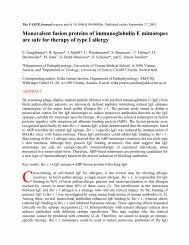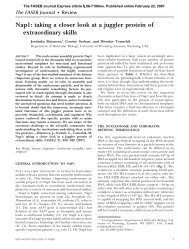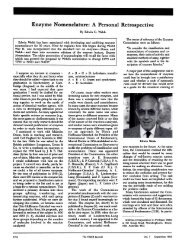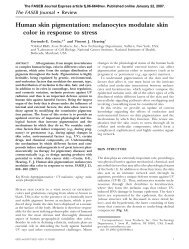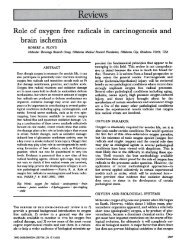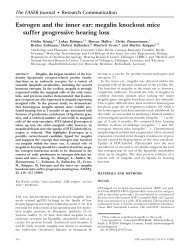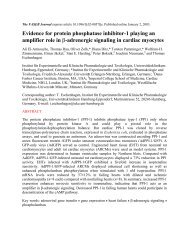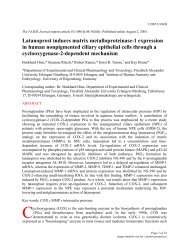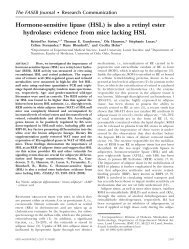Sense and Antisense in Biotech: The First Antisense DNA Company
Sense and Antisense in Biotech: The First Antisense DNA Company
Sense and Antisense in Biotech: The First Antisense DNA Company
Create successful ePaper yourself
Turn your PDF publications into a flip-book with our unique Google optimized e-Paper software.
ployer-employee axis, as I have detailed elsewhere <strong>in</strong><br />
some amus<strong>in</strong>g vignettes (1). His lab <strong>and</strong> m<strong>in</strong>e even<br />
collaborated <strong>and</strong> published together on one occasion,<br />
which was both fun <strong>and</strong> yet a bit contentious when we<br />
were writ<strong>in</strong>g the paper. Our different writ<strong>in</strong>g/presentation<br />
styles aside, this project <strong>and</strong> publication turned<br />
out to have been a good idea (7).<br />
Well before the 1986 paper (6), it had become clear<br />
to both Zamecnik <strong>and</strong> me that his antisense <strong>DNA</strong> work,<br />
especially the HIV axis, might warrant a start-up company.<br />
I was worried about the lack of an issued patent,<br />
th<strong>in</strong>k<strong>in</strong>g that Zamecnik’s 1986 paper might be deemed<br />
obvious <strong>in</strong> light of his (unpatented) 1978 disclosure of<br />
the core idea <strong>and</strong> art of enablement. Yet, I also felt that<br />
the HIV paper had use “written all over it”, <strong>and</strong> <strong>in</strong> at<br />
least U.S. law, this feature can often reign <strong>in</strong> patent<br />
claim allowances.<br />
<strong>The</strong> Worcester Foundation did not have a formal<br />
patent <strong>in</strong>come-allocation policy at the time, nor did<br />
we even have a policy that required our scientists to<br />
assign their rights to the <strong>in</strong>stitution (although I soon<br />
<strong>in</strong>troduced both). Zamecnik was consistently attentive<br />
to the ways the Worcester Foundation might<br />
benefit if his idea became the basis of licensed<br />
<strong>in</strong>tellectual property. I believe this reflected his prior<br />
association with the Worcester Foundation as a<br />
trustee, as well as his gratitude to Hoagl<strong>and</strong> for<br />
hav<strong>in</strong>g taken him <strong>in</strong>. I had also directed some<br />
discretionary funds to his lab after becom<strong>in</strong>g president<br />
<strong>and</strong> was very much beh<strong>in</strong>d his program <strong>in</strong> all<br />
ways, <strong>in</strong>clud<strong>in</strong>g with our trustees <strong>and</strong> donors, <strong>and</strong> I<br />
th<strong>in</strong>k he was grateful for that.<br />
START-UP, OR NOT<br />
Zamecnik’s son is a banker, <strong>and</strong> they were both connected<br />
to their respective A-lists of Boston Brahm<strong>in</strong><br />
gr<strong>and</strong>ees, plus his son had some <strong>in</strong>ternational connections.<br />
Zamecnik also had numerous contacts <strong>in</strong> pharma<br />
who had been medical students, fellows, or house<br />
officers at Mass General, <strong>and</strong> he began conversations<br />
with many of them. By 1987–88, we were both aware<br />
that antisense <strong>DNA</strong> was on the start-up l<strong>and</strong>scape, but<br />
as we later realized, we were not as well connected to<br />
big pharma or the blue-ribbon venture community as<br />
he thought or as I <strong>in</strong>nocently had assumed that we<br />
might be based on his contacts. But R&D representatives<br />
from Merck, Bristol-Myers Squibb, <strong>and</strong> other large<br />
companies were will<strong>in</strong>g to come <strong>and</strong> visit us at the<br />
Worcester Foundation, <strong>and</strong> Zamecnik <strong>and</strong> I also went<br />
to New York to visit a number of banks <strong>and</strong> venture<br />
groups, among which I recall Rothschild Ventures as<br />
be<strong>in</strong>g the most engaged. We also had a visit from<br />
Hambrecht & Quist, <strong>and</strong> my recollection is that Zamecnik<br />
didn’t th<strong>in</strong>k they understood the science. However,<br />
neither Zamecnik nor I had developed a full-scale<br />
bus<strong>in</strong>ess plan (one of our key mistakes), so all of these<br />
companies, banks, <strong>and</strong> venture groups saw us as amateurs—a<br />
charm<strong>in</strong>g <strong>and</strong> brilliant scientist with some<br />
SENSE AND ANTISENSE IN BIOTECH<br />
provocative lab results <strong>and</strong> the cheerful head of his<br />
<strong>in</strong>stitution tagg<strong>in</strong>g along. Also, the Worcester Foundation<br />
had no analogues of Stanford’s Niels Reimer or<br />
MIT’s John Preston sitt<strong>in</strong>g <strong>in</strong> <strong>and</strong> advis<strong>in</strong>g us. In<br />
retrospect, how I wish we had had such m<strong>in</strong>ds at the<br />
table at the time. In October 1988, when Zamecnik <strong>and</strong><br />
the Worcester Foundation had reached a zenith <strong>in</strong><br />
their dyspepsia over how to commercialize antisense<br />
<strong>DNA</strong>, I sought a meet<strong>in</strong>g with MIT’s John Preston, who<br />
was good enough to meet with me <strong>and</strong> offer advice.<br />
This led me <strong>in</strong>to a longst<strong>and</strong><strong>in</strong>g relationship with<br />
Preston’s successor, Lita Nelsen, who, like Preston,<br />
shared valuable time with me, even though I was not at<br />
MIT nor was this MIT <strong>in</strong>tellectual property. Nelsen’s<br />
generous will<strong>in</strong>gness to help me th<strong>in</strong>k through the<br />
start-up situation <strong>and</strong> later, licens<strong>in</strong>g issues is someth<strong>in</strong>g<br />
for which I shall be forever grateful to her.<br />
ALMOST THE FIRST ANTISENSE <strong>DNA</strong><br />
COMPANY<br />
<strong>The</strong> Worcester Foundation, of course, had filed a<br />
patent application prior to Zamecnik’s HIV publication,<br />
<strong>and</strong> by mid-1988, we had gotten an Allowance of<br />
Claims, lead<strong>in</strong>g us to start a different conversation with<br />
potential <strong>in</strong>vestors, given that some degree of patent<br />
protection was now a realistic possibility. Thus armed,<br />
Zamecnik <strong>and</strong> I, together or <strong>in</strong> other cases on our own,<br />
embarked on another round of discussions with<br />
pharma <strong>and</strong> banks but still with the same headaches<br />
after every meet<strong>in</strong>g. But then, Zamecnik came upon a<br />
Harvard Medical School-launched venture fund. It was<br />
<strong>in</strong>itially called Ion Corp., but by the time Zamecnik<br />
contacted the company, it was known as Medical Science<br />
Partners. Harvard Medical School’s idea was to have<br />
this entity provide, or help provide, access to seed capital<br />
to nucleate start-ups based on the <strong>in</strong>stitution’s <strong>in</strong>ventors<br />
<strong>and</strong> licensable technology. Zamecnik’s courtship of Medical<br />
Science Partners was technically off-base, as he was no<br />
longer at Harvard, nor did it hold any rights to his<br />
<strong>in</strong>ventions. However, Zamecnik was still an emeritus professor<br />
at Harvard Medical School, <strong>and</strong> this got him access<br />
(conversationally, at least) to Medical Science Partners.<br />
We had several meet<strong>in</strong>gs with its partners, André Lamotte<br />
<strong>and</strong> Joseph Lovett, <strong>and</strong> Zamecnik <strong>and</strong> I both felt<br />
that this was look<strong>in</strong>g like a productive axis of conversation.<br />
Yet, Zamecnik had been bitterly disappo<strong>in</strong>ted by<br />
the reaction of pharma, as well as the negativity of the<br />
banks that we had visited <strong>in</strong> Manhattan. As is often as<br />
the case with an <strong>in</strong>ventor <strong>and</strong> visionary, he saw his<br />
concept as a perfect Aristotelian-Cartesian reality, but I<br />
viewed it, from my own nucleic acid expertise, as a very<br />
high mounta<strong>in</strong>, not as lab science but <strong>in</strong> the cl<strong>in</strong>ic.<br />
However, I had to put aside my concerns about antisense<br />
as medic<strong>in</strong>e, because as president of the Worcester<br />
Foundation, I had the responsibility to do everyth<strong>in</strong>g<br />
that I could to turn his work <strong>in</strong>to both an entity to<br />
hopefully, <strong>in</strong> some possible way, improve the human<br />
condition <strong>and</strong> also, to potentially return some money to<br />
3597



